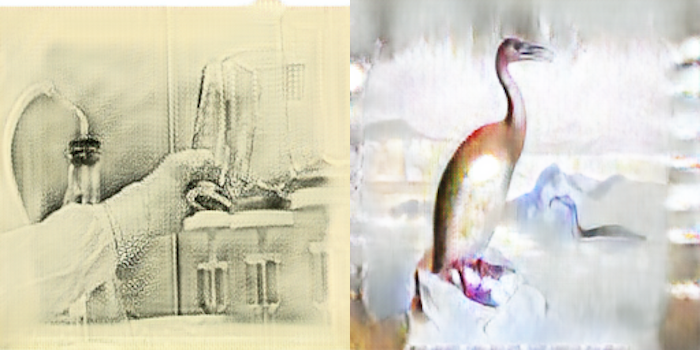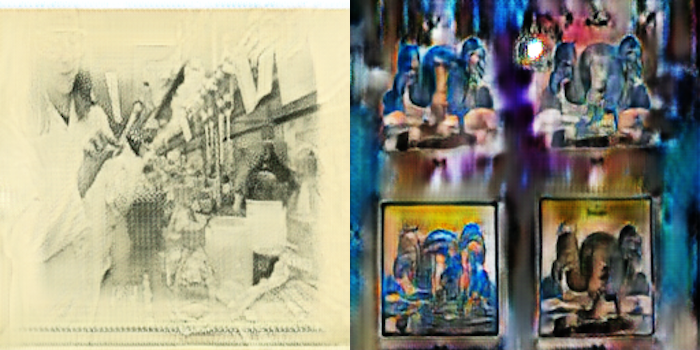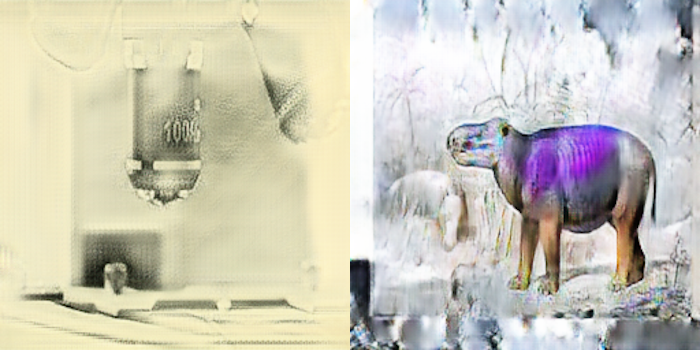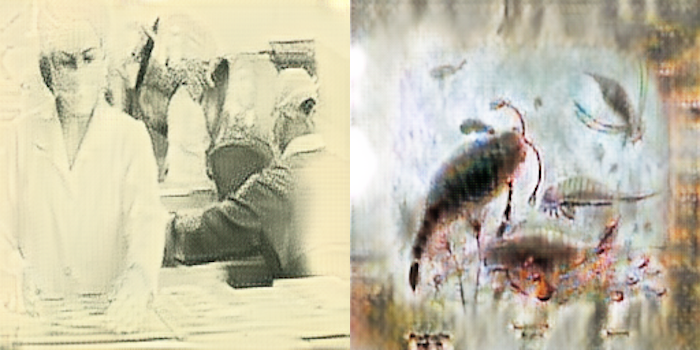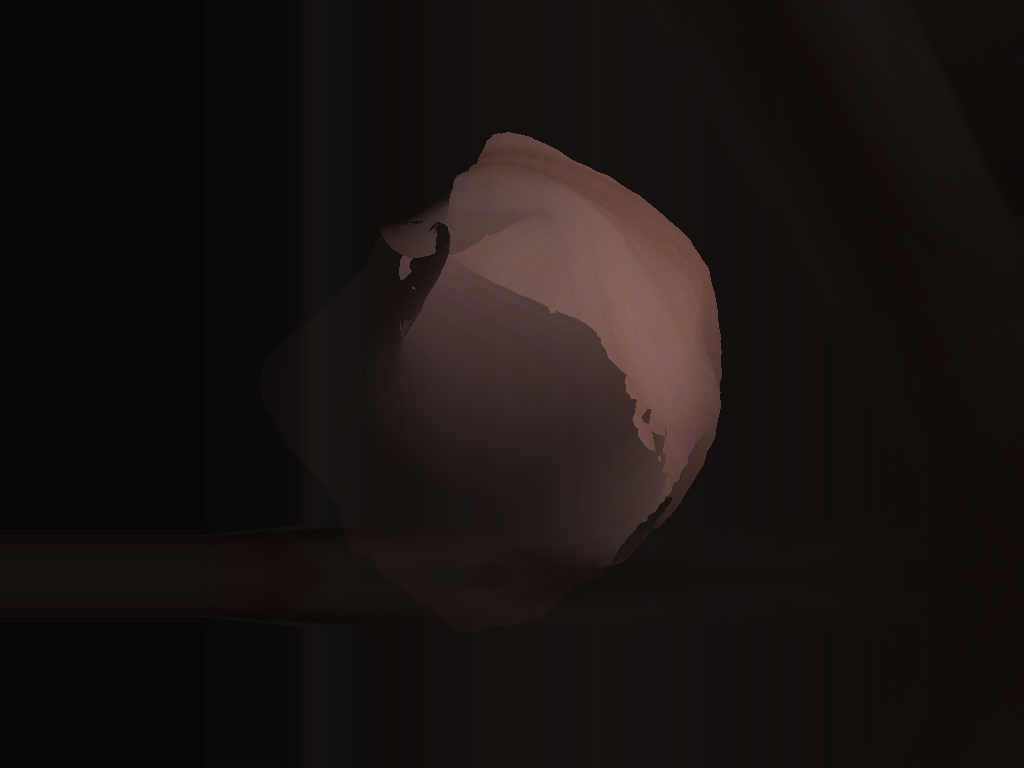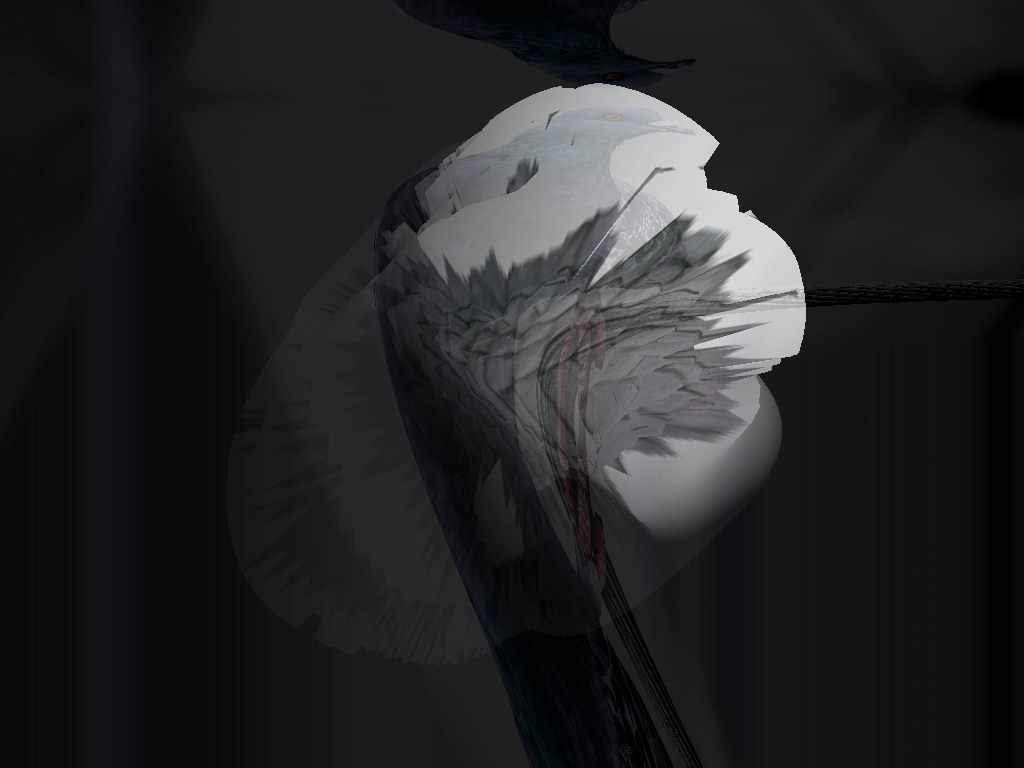Copy-pasting the Lost Time
Reprogramming Species as Rhetorical Software
By: Veera Jussila
When armed with a computer, the world becomes data and relations appear as systems (Brain, 2017).
Fossiles used to be representations of the past. However, when 28 0000-year-old remains of a woolly mammoth were found in the Siberian permafrost in 2011, they soon became a symbol of the future. Pieces of the DNA of “Yuka” have showed signs of biological reactions when inserted inside mouse eggs (Yagamata et al 2019).
At the same time, another researcher group has been copying DNA from mammoth genome into living elephant cell cultures. This novel technology is called CRISPR-Cas9. According to researchers, mutations “for mammoth hemoglobin, extra hair growth, fat production, down to nuanced climate adaptations such as slightly altered sodium ion channels in cell membranes have already been engineered into fibroblast cell lines.” Other species could follow: in 2019, a male laboratory pigeon “Apsu” tested positive for carrying the lab-made mutation gene, opening up new possibilities for reviving extinct passenger pigeons in the bodies of living birds. (Revive & Restore [n.d.]).
These developments deal with computation, control and multispecies relationships in way that seemed to deserve examination via practice-based research. The language of the experiments mirrors the language of programming; also, their approach to time seemed worth researching with time-based media.
Firstly, this essay discusses gene editing and genetical resurrection as examples of the intertwining of computation and biology. It is argued that this kind of “reprogramming” nature can be seen as rhetorical software and that current tendencies in machine learning give this software a new kind of authority. It is then examined how genetic de-extinction practices resonate with Donna Haraway’s themes of multispecies storytelling. This research suggests that there is a tension, as the resurrection projects tend to centre around human’s sense of time and place. However, they can also be seen through emotional motives. Jørgensen (2019) sees de-extinction as a nostalgic project that stems from grief and takes place via biocultural negotiations. This interpretation can resonate both with feminist techno-science and what McQuillan’s (2018) calls for as a counterculture in machine learning. Finally, alternative ways of staying with the (extinction) trouble are examined with what Burrows and O’Sullivan (2019) call as fictioning.
Intertwining of computation and biology is not new. Chun et al (2011, p. 101) discuss how the histories of both fields are “littered with moments of deliberate connection and astonished revelation”. We refer to computer storage as “memory” and talk about regulatory genes as “switches”. Through generative misreadings, authors state, biology and computation are “constructed as complementary strands of a constantly unraveling andraveling stylized double helix”. They are reduced to corresponding strips thought the “sleek simplicity of programmability” – “even as they work in opposite directions”. (ibid., p. 24, 101–102)
One example is the view of environment as a system. Due to climate change, there is an increasing urge to fix the parts of the system that are broken. Drone re-seeders and climate engineering tools are proposed as a means of automated “curation” of wild places, the unprejudiced computational intelligence having “a unique platform to perform the task of creating novel ecologies” (Cantrell, Martin and Ellis 2017, p. 5–7).
Paradoxically, these ecologies are becoming more difficult to manage. As patterns in climatic phenomena are radically disrupted, it becomes increasingly hard to make predictions with the data we have at hand now (Brain 2017). Furthermore, Orit Halpern (2017) writes about “hopeful resilience” that overlooks the uncomfortable side-effects of these new “systems”. As an example, she refers to an artwork that proposes oyster reefs as ecological barriers for New York. However, oysters would slowly die as a result of the toxic water. (ibid.)
How are CRISPR-Cas9 and de-extinction linked to this? It can be argued that they suggest a new level of programmability of Earth that also stretches over time in a novel way. CRISPR-Cas9 technology is commonly referred to as “gene scissors”. It consists of two key molecules that cause a mutation in the DNA. Enzyme Cas9 cuts the two strands of DNA at a specific location so that bits of DNA can be removed or added. A pre-designed RNA sequence helps Cas9 to find the target. When the cell recognizes its DNA is damaged, it tries to repair it and causes the mutation. (Yourgenome 2016) In this world of programmability, mutations are treated like changes in animation after removing bits of code.
Most of the controversy around CRISPR-Cas9 is focused on its potential use on humans. However, CRISPR-Cas9 is already pursued as a way to edit non-human species – for example, to create a population of mice that would not spread diseases (Specter 2016). De-extinction is another example. Harvard-based organization Revive & Restore has been the most visible advocate for bringing back species like woolly mammoths. In fact, woolly mammoths and passenger pigeons have become the poster children of the resurrection movement (Jørgensen 2019, p. 114). The idea is to copy-and-paste (sic.) DNA from the decoded mammoth genome into living Asian elephant cell cultures and from the passenger pigeon genome to living rock pigeon cell cultures, resulting in so called gene drive where the coming generations are hybrids. The “new” woolly mammoths, for example, would then be introduced “back” to the tundra in the hopes of converting it back to grasslands, which would then equester carbon from the atmosphere. (Revive & Restore [n.d.])
This all fits what Chun et al (2011, p. 97) write about computation as a means of regenerating archives. According to them, genetics “separated cultural and biological transmission”, but also “made biological transmission a question of transmissible, cultural knowledge—a question of and for the archive” (ibid., p. 121). In CRISPR-Cas9 de-extinction projects, old data is retrieved from the memory in the hopes of producing the kind of software that is considered desirable.
Moreover, machine learning has become a way to make this regeneration more effective. Models predict how successful CRISPR will be in cutting the targeted part of genome (Desktop Genetics [n.d.]). The underlying idea is of machine learning as a stabilizer for science, making the complex predictions more reliable.
The idea of managing nature with seemingly neutral machine learning has been criticized by many. Brain (2017) writes that data driven approach assumes that the past is indicative of the future. New statistical approaches, she writes, “derive models from pattern in large quantities of data without any knowledge of underlying structures, whether these are language, environmental processes or genomics.” Yet climate change renders even the largest datasets obsolete. (ibid.) In their artwork Asunder, Brain, Julian Oliver and Bengt Sjölén (2019) present a fictional AI manager that calmly calculates fixes to planetary challenges, including the re-icing of the Arctic.
Notably, even the most automated machine learning processes are initially selected by humans and determined by the resources. Drawing from this tension, McQuillan (2018) examines data science as a form of machinic neoplatonism. He refers to the ideas that informed the early science of Copernicus and Galileo: that science can reveal a hidden mathematical order in the world. According to McQuillan, a change of paradigm is taking place. Data scientists don’t claim to reveal causal relationships like in physical sciences. Still machine learning algorithms are increasingly used as a justification for action in the world. According to McQuillan, “data science appears to emulate science by transforming empirical data into patterns of regularity which have predictive power”. The logics of neural networks themselves hide behind complex maths and commercial secrecy. (ibid.) Similarly, Tanz (2016) observes that because of all the auto-learning and auto-coding, neural networks generate guesses with a language that “even the best coder’s can’t fully understand”.
It is intriguing to think about these developments through the concept of rhetorical software. With the term, Richard Doyle refers to “the relational and material interactions that make possible the emergence of scientific statements”. Like software turns words into action, “the rhetorics of code, instruction and program materialized beliefs into sciences and technologies”. (Doyle 1997 cited by Chun et al 2011, p. 105) From this point of view, the “reprogramming” of mammoth cells wouldn’t be taking place without the already established rhetorics of programming. This focus on code as the source of life is very clear in the accounts of the mammoth project: “To date a number of genes have been successfully rewritten into Asian Elephant cell lines, generating increasingly mammoth-like cells with each precise edit” (Revive & Restore [n.d.]). This kind of processes can take place without machine learning; however, with machine learning the rhetorical software of reprogramming gains a new kind of authority.
These practices can be questioned from many viewpoints. Firstly, they seem to further enable the instrumental manipulation of what we label as “objects” (McQuillan 2018, see also Haraway 1988, p. 581). Of course, it can be argued that some mammoth genes won’t cause harm to animals if carefully planned. However, at the moment this is speculation where programming won’t lead into bugs. Another problem is what Arendt (2006, cited by McQuillan 2015) calls thoughtlessness. If humans are not fully able to understand how algorithms retune CRISPR-Cas practices, the potential for accountability is further undermined.
As a response to the new paradigm, McQuillan calls for a counterculture of machine learning via agential realism, a concept by Karen Barad (2007, cited by McQuillan 2018). In this view, there is no object without measurement, the line between subject and object is in flux and agency emerges from the iterative production of reality. McQuillan calls for a critical pedagogy in machine learning where the questions to be asked and interpretations of predictions are open to a participatory reworking. (ibid.) Correspondingly, Brain (2017) suggests “eccentric engineering”: testing technologies to reveal their ideologies and edges for reworking.
Inspired by these accounts, I chose to test neural networks in my approach to reprogramming rhetorics. I wanted to use them in a subjective and almost fragile way to examine the de-extinction projects. This meant working with small, handpicked datasets.
I finally chose five open access image albums of extinct species from Biodiversity Heritage Library. They included 158 scientific drawings about species that were already lost during the time of the drawings. For the other part of the dataset, I uploaded photos from Unsplash with keywords like “science” and “lab”, giving me a set of colorful, detailed depictions of modern science.




Following McQuillan and Barad, I wanted to question the lines between objects that are observed and those who stand outside. The aim was to reprogram the scientific tradition itself into an object that can be observed and traced in time.
I used the PyTorch version of CycleGAN by Zhu et al (2017). I had found it to be suitable for capturing the kind of in-between stages that this research was interested in. The actual neural network behind the code is heavy and complex; in fact, using it in this kind of handmade experiment felt like challenging the very idea of machinist predictability.
After 200 epochs with learning rate of 0.0002 and another 200 epochs with decay towards zero, new imaginaries had emerged:
The cool, saturated colors and the strive for detail had been passed to the images of extinct species, whereas lab photos had become the object of examination and archives. Surprisingly, it is as if the image pairs would describe the resurrection attempts themselves. Liquid is poured into a measuring glass, and suddenly a vivid animal appears.
The whole idea of reprogramming species can thus be seen as rhetorical software. However, as it concerns the relationships of human and inhuman species – could it be seen alternatively through something that Haraway (2016) calls multispecies storytelling?
At first sight, it would seem easy to do so. As Gabrys (2016, 63) analyzes, Haraway’s account emphasizes the bodily and material meetings across technologies, humans and more-than-humans. “Worldly embodiment”emerges from these contact points, suiting Braidotti’s (2013, p. 90) ideas of technology as a tool for posthuman subjectivity. From this point of view, de-extinction projects could maybe be seen as attempts to connect with companion species. There is also the concept of staying with the trouble: environmental problems caused in part by humans but also by other factors (Burrows & Sullivan 2019, 288). According to Haraway (2016, p. 29), we are “responsible to and for shaping conditions for multispecies flourishing in the face of terrible histories”. Also, companion species can collaborate in tackling environmental problems (p. 20). Like discussed before, proponents the woolly mammoth project address resurrection as way to fight climate change.
However, it can be argued that the reprogramming rhetorics don’t resonate with multispecies storytelling. When talking about lost species, we inevitably talk from our own time perspective, highlighting that history itself involves a species-specific concept of time (Burrows & O’Sullivan 2019, 281). We don’t witness these species anymore: therefore, they are lost. However, as Burrows and O’Sullivan (ibid., 281) point out, these actors don’t necessarily share the sense of space and time with us. Thus, imagining that tundra wants its mammoths back or that passenger pigeons want to come back is essentially not a multispecies view of things. In fact, especially the project of bringing the mammoths back echoes the kind of narratives of modern science that Ursula Le Guin (1996, 149) writes about: “the mammoth hunters spectacularly occupy the cave wall and the mind”. It also lifts humans to a central role as shapers of the history and future of the planet. In Haraway’s multispecies account, flourishing or extinction of species is not necessarily directed by humans – a virus, for example, can take that role as well (Burrows and O’Sullivan 2019, 281).
One comparison point is the Crittercam project. In Crittercam, video cameras were attached to marine creatures in order to bring animals point of view to scientific discussion (Gabrys 2016, 63–64). Similarly, in the Pigeonblog project, racing pigeons were gathering air pollution data in a multispecies collaboration (Haraway 2016, 22). Haraway sees these both as a technological relation that includes becoming-with (Gabrys 2016, 2016, 63-64) other species. This relation seems different from the one with CRISPR-Cas9. In Crittercam and Pigeonblog, data is gathered in order to support multispecies flourishing. Sensing is seen as a shared if an asymmetrical practice (ibid., p. 64). Genetic resurrections, on contrast, set humans as subjects who not only examine other species, but move and introduce them according to their own sense of space and time – potentially causing unexpected consequences to the creatures and environments that are seen as a part of a system.
This all raises a question: would there be an alternative way of programming with the trouble and committing to multispecies storytelling?
For this, some history studies from Norway offer a fruitful starting point. Dolly Jørgensen (2019) argues that de-extinction attempts can be seen as a nostalgic practice that justifies future actions with the concept of belonging. A species is seen to belong to a certain space and time. Belonging, according to Jørgensen, is constructed and negotiated through biocultural relationships instead of being a fixed category. The whole concept of species itself is a historical construction as well. Discussions about native and non-native species reveal these ongoing negotiations of belonging. (ibid., p. 8-9)
What is remarkable is that Jørgensen analyzes even the most hi-tech de-extinction experiments as results of emotions, motivated by grief, longing and collective guilt. These emotions change shape over time. For example, in 1914, the mournful reports of the death of the last passenger pigeon Martha replaced the anger caused by extinction with a grief narrative. Now, the excitement around reprogrammed pigeons and mammoths is motivated by a new, hopeful phase of the grieving. This account is in stark contrast with the centuries-old idea of humans being rational in their relationship with nature. According to Jørgensen, the urge for de-extinction is one result of realizing the fundamental effects of industrialization on nature – in other words, a reaction to Anthroposcene. (Jørgensen 2019, p. 5, 9, 109)
Arguably, this view can resonate with feminist technoscience and even McQuillan’s critique of data science. All emphasize that we have a subjective position in our relationships with other species or things we label as objects. It is also about questioning who “we” are in these discourses: is it really so that “we” are responsible for species that “we” have destroyed, regardless of economic status, gender and race (Jørgensen 2019,p. 54)? Experiments like resurrection via CRISPR-Cas9 are proposed as neutral solutions to biodiversity loss and climate change. However, motives are diverse. It is one thing that gene editing has become a business with companies like Mammoth Biosciences. But it also seems that, by treating the very anxiety caused by biodiversity loss with reprogramming other species, we might to push the actual kinship further away.
Here emerges a place for practice that Burrows and O’Sullivan (2019) call fictioning. It can be described as speculative world-making, mapping out “alternatives to the dominant fictions of reality” like the ambient post-truth information environments. For authors, one central aspect is fictioning worlds beyond a human-centered viewpoint. (ibid., p. 10, 46)
In my research, I see software as a fitting tool for fictioning multi-species relationships and concepts of time. The almost fiction-like realm of reprogramming species back from the collective memory lends itself to alternative imageries. Who is being observed? Whose time perspective is used? Are we actually moving to the future or past? How would the new and old species co-habit the planet? What would the rhetorical software look like as an instrument? What is the role of human and machine in these fictional practices? I’m interested in what Marques(2019) calls parallel futures: the continuum that we already share with other livelihoods. In the context of extinction, this could mean turning our attention to (maybe some less charismatic) species that we share the planet with now while at the same time recognizing the feelings of loss relating to the extinct species.
In my research, I decided to study this with a virtual time machine in openFrameworks that allows fictioning future, past and present. The user can travel in time by rotating the object – bringing sights of species that are part of the past, present or future.
The program has several FBO:s as layers. Their images come from Biodiversity Heritage Library, Unsplash and the mammoth image from Wikimedia Commons. Just like in the CycleGAN part of the research, the boundary between past, present and future is blurred with the chancing contents. Every now and then, the user is captured in a FBO via video: it reminds that the object exists only with an observer (Barad 2007, cited by McQuillan 2018). In the exhibition space, the users could also see themselves turning time from video screens.
The object itself is a sphere, suiting the passing of time on planet and referring to the shape of crystal balls as well. The deformations and rotation of the object are only partly controllable. Applying Garnet Hertz’s (2017) concept, the software could maybe be seen as a half-disobedient object, highlighting the uncertainty that is involved in approaching nature as a system. As a part of the research, I have studied several ways to implement the interaction. With TouchOSC and GyrOSC, moving back and forth in time is easier than sending a text; with GyrOSC, the phone can even be hidden in a physical ball that the user rotates to rotate the virtual object on the screen. With image classification and ofxRapidLib library, I was able to train the program with my hand positions and then turn time by waving my hand. Sometimes there was a drastic jump to a class that I had not planned, which also suited my machine learning themes quite well. With optical flow, the incoming values changed constantly; this also, apparently, resulted in such noise that the features of the user could not be distinguished from the video buffer. While this was a bit too abstract for my purpose, it was interesting in relation to themes of opacity and thoughtlessness.
Just like environment, the software includes patterns and rules that the user is not aware of. Every 60 seconds, the program freezes a frame – a kind of a virtual monument of our multispecies configurations. The unexpected nature of the snapshots resists the epic, Jurassic Park -like narratives of de-extinction projects that Jørgensen (2019, p. 116) writes about and Le Guin (1996, p. 153–154) sees typical for modern science in general. With this software, it is not possible to bring back the woolly mammoth as it was. In fact, the monuments are slightly different each time. Is it even a pigeon of the past or present? Similarly, sound artist Sally Ann McIntyre has studied a vague recording of New Zealand bird kōkako that refuses “to be pinned down to monumental extinction narratives”. In a same way, the eerie snapshots from the time machine highlight “the human specificity of knowledge, and all that is left outside of it”(McIntyre 2016).
To conclude, the work examines re-membering and com-memorating (Haraway 2016, p. 25) as an alternative to de-extinction practices. According to Haraway (ibid., p. 28), “response-ability” can mean remembering “who lives and who dies and how in the string figures of naturalcultural history”.
At this point, the program is in a draft stage. The aim is to build it into an interactive installation where shapshots are projected on the wall – with the options to move up and down in time as well.
This essay has examined modern de-extinction attempts as examples of the intertwining of computation and biology. The idea of programmability is especially clear in new CRISPR-Cas9 experiments where pieces of DNA are literally copy-pasted. These projects are presented like software updates where old data is retrieved from the memory and re-written to produce the kind of new software that is considered desirable. These developments are increasingly directed by machine learning algorithms that are used as a justification for action in the world. Richard Doyle’s (1997 cited by Chun et al 2011, p. 105) concept of rhetorical software captures several of the discussed points: without the rhetorics of computing, the idea of “reprogramming” mammoth cells would hardly exist. Next, it was studied how re-programming attempts suit Haraway’s ideas of multispecies storytelling and companion species. It is argued that there is not the kind of shared sensing and cooperation that would allow becoming-with other species. Finally, de-extinction experiments are discussed as nostalgic projects that blur the lines between future and past and that are justified with the notion of belonging. This opens possibilities for fictioning: for re-imagining concepts of time and relationships with existing and lost species. This offers an alternative for the heroic, linear narratives of humans controlling nature.
Following Salter and Pickering (2015, p. 14), this research has been a process by which things come to be. For example, in the beginning I was not aware of Jørgensens (2019) studies that proved to resonate with the more computational theories. In the future, it might be interesting to research how the belongings and not-belongings of species are built and use – perhaps somewhat disobedient – machine learning classifications to play with that.
Annotated Bibliography
Burrows, D. and O’Sullivan, S. (2019) Fictioning. The Myth-Functions of Contemporary Art and Philosophy. Edinburgh: Edinburgh University Press.
In this book, authors map out their practice of fictioning as an open-ended, experimental approach to arts and philosophy. Fictioning seeks to “map out alternatives to the dominant fictions of reality” and has, thus, political charge to it (p.10). Like Donna Haraway, Burrows and O’Sullivan are interested in inhuman social imaginaries. For this research, their account offers both a theoretical framework and inspiration for twisting the existing narratives.
Haraway, D. (2016) Playing String Figures with Companion Species. In Staying With The Trouble: Making Kin in the Cthulucene, p. 9–29. Durham: Duke University Press.
In this short text, Haraway discusses the relationships of what she calls companion species. Committing to multispecies storytelling requires the active reciprocity of partners: they become-with in these meetings. This interconnectedness is similar to string figure games. For this reseach, it was intriguing to reflect on how the resurrection attempts resonate with Haraway's account. It is argued that the dynamics are different from the multispecies collaboration taking place in Pigeonblog, for example.
Jørgensen, D. (2019) Recovering Lost Species in the Modern Age. Histories of Longing and Belonging. Cambridge: The MIT Press.
Jørgensen, working as a Professor of History at University of Stavanger, discusses de-extinction attempts as a nostalgic practice. She emphasizes how the concepts of species and where they belong are constantly negotiated; however, motivation for these negotiations is often emotionally charged. Like Haraway, Jørgensen ultimately challenges the idea where science would offer a neutral view on our multispecies relationships.
McQuillan, D. (2018) Data Science as Machinic Neoplatonism. Philosophy & Technology, 31, p. 253–272 [online]. Available at: https://doi.org/10.1007/s13347-017-0273-3 (Accessed: 29 April 2020)
According to McQuillan, data science is not “simply a method but an organizing idea". He discusses how data science appears to emulate science and, thus, gains a similar authority. In his account, complex machine learning models offer “insight through opacity". He proposes a counterculture that would challenge the current neoplatonist tendencies; this research has been strongly inspired by this idea.
References
Braidotti, R. (2013) The Posthuman. Cambridge: Polity Press.
Brain, T. (2017) The Environment is not a System. Research Values 2018 [online]. Available at: https://researchvalues2018.wordpress.com/2017/12/20/tega-brain-the-environment-is-not-a-system/ (Accessed: 1 May 2020)
Brain, T., Oliver, J. and Sjölén, B. (2019). Asunder. Uncanny Values [online]. Available at: https://uncannyvalues.org/works/asunder (Accessed: 1 May 2020)
Brown, M. (2020) Crystal Palace's lifesize dinosaurs added to heritage at risk register. The Guardian, 20 February [online]. Available at: https://www.theguardian.com/culture/2020/feb/28/crystal-palaces-lifesize-dinosaurs-added-to-heritage-at-risk-register (Accessed: 4 May 2020)
Cantrell, B., Martin, L. J. and Ellis, E.C. (2017). Designing Autonomy: Opportunities for New Wildness in the Anthroposcene. Trends in Ecology & Evolution, 32(3), p. 156– 166. Available at: https://www.researchgate.net/publication/312511655_Designing_Autonomy_Opportunities_for_New_Wildness_in_the_Anthropocene (Accessed: 1 May 2020)
Chun, W., Fuller, M., Manovich, L. and Wardrip-Fruin, N. (2011) Programmed Visions: Software and Memory. Cambridge: The MIT Press.
Desktop Genetics ([n.d.]) Applying Machine Learning to CRISPR [online]. Available at: https://www.deskgen.com/landing/#/blogs/machine-learning-crispr-guide-design (Accessed: 1 May 2020)
Gabrys, J. (2016) Program Earth. Environmental Sensing Technology and the Making of a Computational Planet. Minneapolis: University of Minneapolis Press. Available at: https://www.upress.umn.edu/book-division/gabrys_pdf (Accessed: 1 May 2020)
Halpern, O. (2017) Hopeful Resilience. In e-flux Architecture and Daniel A. Barber: Accumulation [online]. Available at: https://www.e-flux.com/architecture/accumulation/96421/hopeful-resilience/ (Accessed: 1 May 2020)
Haraway, D. (1988) Situated Knowledges: The Science Question in Femism and the Privilege of Partial Perspective. Feminist studies, vol. 14, no.3, p. 575–599.
Hertz, G. (2017) Disobedient Electronics [online]. Available at: www.disobedientelectronics.com (Accessed: 29 April 2020)
Le Guin, U.K. (1996) The Carrier Bag Theory of Fiction. In: Glotfelty, C. and Fromm, H. , ed., The Ecocriticism Reader. Landmarks in Literary Ecology. Athens: University of Georgia Press, p. 149–154.
Marques, P. N. (2019) Parallel futures: one or many dystopias?E-flux, journal#99 [online]. Available at: https://www.e-flux.com/journal/99/263702/parallel-futures-one-or-many-dystopias/ (Accessed: 29 April 2020)
McIntyre, S. A. (2016) 'Das Große Rauschen: the Metamorphosis of Radio' at Radio Revolten Zentrale, Halle. Radio Cegeste 104.5 FM, 24 September [online]. Available at: http://radiocegeste.blogspot.com/2016/09/das-groe-rauschen-metamorphosis-of.html (Accessed: 1 May 2020)
McQuillan, D. (2015) Hannah Arendt and Algorithmic Thoughtlessness, 29 June [online]. Available at: http://danmcquillan.io/arendtandalgorithms.html (Accessed: 1 May 2020)
Revive & Restore ([n.d.]) Woolly Mammoth Revival [online]. Available at: https://reviverestore.org/projects/woolly-mammoth/ (Accessed: 1 May 2020)
Salter, C. and Pickering, A. (2015) Alien Agency: Experimental encounters with art in the making. Cambridge: MIT Press.
Specter, M. (2016) Re-writing The Code of Life. The New Yorker, 26 December [online]. Available at: https://www.newyorker.com/magazine/2017/01/02/rewriting-the-code-of-life (Accessed: 29 April 2020)
Tanz, J. (2016) Soon We Won’t Program Computers. We’ll Train Them Like Dogs. The Wired, 17 May [online]. Available at: https://www.wired.com/2016/05/the-end-of-code/ (Accessed: 1 May 2020)
Yagamata et al. (2019) Signs of biological activities of 28,000-year-old mammoth nuclei in mouse oocytes visualized by live-cell imaging. Sci Rep 9, 4050. Available at: https://doi.org/10.1038/s41598-019-40546-1(Accessed: 4 May)
Yourgenome (2016). What is CRISPR-Cas9? [Online]. Available at: https://www.yourgenome.org/facts/what-is-crispr-cas9 (Accessed: 1 May 2020)
Zhu, J.Y. et al (2017) Unpaired Image-to-Image Translation using Cycle-Consistent Adversarial Networks. ICCV 2017. Available at: https://junyanz.github.io/CycleGAN/ (Accessed: 2 May 2020)































































